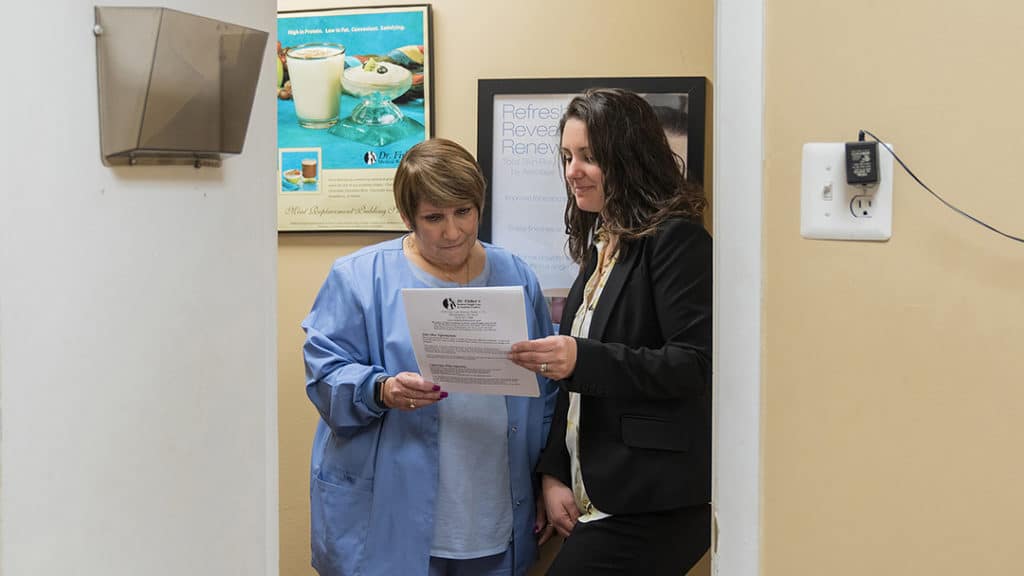
How To Safely Lose Weight With Type 1 Diabetes
Losing weight with Type 1 Diabetes requires careful planning and smart choices. In this guide, we’ll show you how to do it safely. You’ll learn how to work with healthcare professionals to craft a diet and exercise plan that suits your life, manage your blood sugar, and understand the impact of weight loss on your diabetes.
By the end of this article, you’ll be equipped with the knowledge to pursue your weight loss goals without compromising your health.
How To Safely Lose Weight With Type 1 Diabetes
To safely lose weight people with Type 1 Diabetes must prioritize blood sugar management while following specific steps tailored to their condition.
Before starting any weight loss program, it is important to seek advice from healthcare professionals such as doctors and diabetes educators. They can provide personalized recommendations based on individual factors such as body composition and daily insulin needs. It’s crucial to establish achievable weight loss goals that take into account these factors.
Crafting a balanced meal plan is also important. Prioritizing nutrition, such as lean protein from meats, while controlling calorie and fat consumption can prevent unnecessary weight gain. Incorporate high-fiber foods to ensure satiety and manage food intake, and opt for low glycemic index foods for steady energy, which is essential in managing body fat percentage.
In terms of physical activity, finding the right exercise regimen is essential. This involves a mix of strength training to build muscles and cardio exercises while considering your daily dose of insulin. Ensuring safe workouts means monitoring blood sugar levels closely and staying hydrated and energized.
Mastering insulin management is another vital aspect of the process. Adjusting the insulin dose per injection based on physical activity and eating habits ensures optimal blood sugar management. Recognizing and treating both hypo and hyperglycemia promptly is essential for people with Type 1 Diabetes.
Understanding how weight loss affects blood sugar variability ensures that individuals can adjust their lifestyles while keeping the disease in check. Just remember that even a small percent change in weight can significantly impact your weight loss goals and overall health.
1. Consult with Healthcare Professionals Before Initiating Weight Loss
Before initiating weight loss, it’s imperative to consult with healthcare professionals to ensure a safe and personalized approach, particularly for people with diabetes.
This collaborative step allows you to harness expert advice and receive medical nutrition therapy, which is tailored to your unique health requirements and diabetes care objectives. When working with a healthcare provider, you will gain insights into how a healthy diet influences your body function and how to manage it alongside your condition. They can guide you on a balanced, low-glucose diet that aligns with your calorie intake needs and metabolism from foods.
With professional oversight, you can identify food choices that will serve as an adequate energy source, maintaining your energy levels without compromising blood sugar control.
2. Establish Realistic and Achievable Weight Loss Milestones
Setting realistic and achievable weight loss milestones is crucial for maintaining motivation and ensuring the sustainability of your health journey.
A well-structured plan begins with understanding how a calorie deficit aligns with the unique energy needs of the human body, especially in the context of diabetes management. A diet with nutrient timing can significantly affect weight loss success, as it helps in optimizing the absorption of nutrients and maintaining steady blood sugar levels.
The aim is to develop a progression of weight goals that reflect a deep understanding of how your body responds to changes in calorie intake and diet. By doing so, each milestone becomes a stepping stone that brings you closer to your ultimate goal, promoting long-term changes in weight and health, without compromising the intricate balance required for optimal body function.
3. Craft a Balanced Meal Plan for Weight Loss with Type 1 Diabetes
A balanced meal plan for weight loss with Type 1 Diabetes must strategically include a variety of nutrients while considering daily calorie intake.
This involves selecting whole foods and implementing a low-carb eating pattern to manage blood sugar. Proper meal schedules and portion control, guided by a clear understanding of nutrition, can prevent a lack of control and promote a gradual, healthy weight reduction.
Structuring meals around a calorie intake goal is essential, as it encourages a consistent intake that supports the body’s needs without the risk of starvation repercussions.
4. Incorporate High-Fiber Foods for Satiety and Blood Sugar Control
Integrating high-fiber foods into your diet can help in achieving satiety and regulating blood sugar levels.
High-fiber options reduce the likelihood of episodes of binge eating and help maintain a stable energy release. By focusing on plant-based eating, individuals can avoid disordered patterns and foster healthier habits around food. Reading labels carefully to understand fiber content is an essential part of this approach, ensuring that the daily calorie intake supports the weight loss journey effectively.
5. Opt for Low Glycemic Index Foods for Steady Energy
Choosing low glycemic index foods is key to maintaining steady energy levels throughout the day.
Such foods are integral to low-carb diets because they help avoid blood sugar spikes and dips. A diet emphasizing these foods aligns with a high-protein diet, which can assist in preserving muscle mass while losing weight.
As a result, the individual can enjoy sustained energy without the risk associated with a high intake of simple sugars, promoting an overall healthier lifestyle that supports diabetes management. This approach can offer a varied and satisfying menu that contributes to a feeling of fullness and aids in sticking to a set calorie plan.
6. Find the Right Exercise Regimen for Weight Loss with Type 1 Diabetes
Finding the right exercise regimen for weight loss with Type 1 Diabetes involves selecting activities that not only burn calories but also maintain blood glucose levels within a safe range.
The regimen should balance cardiovascular exercises, which aid in fat burning, with strength training to build muscle mass and enhance insulin sensitivity. Tailoring the intensity and duration of workouts to individual fitness levels and blood sugar responses is key.
Consulting with a diabetes care team can provide guidance on how different forms of exercise might affect blood glucose and how to adjust insulin dosages accordingly. It’s also beneficial to integrate flexibility and balance exercises to improve overall physical function and reduce injury risk.
7. Ensure Safe Workouts by Monitoring Blood Sugar Levels
To ensure safe workouts for people with Type 1 Diabetes, it is necessary to monitor blood sugar levels before, during, and after exercising.
Keeping a close eye on blood sugar can help prevent both hyperglycemia and hypoglycemia, which can be dangerous and counterproductive to fitness goals. Adjust food intake or insulin dosage before exercising to maintain stable glucose levels.
Wearing a continuous glucose monitor (CGM) during workouts can provide real-time feedback and allow for prompt adjustments. Understanding how your body reacts to different types of physical activity will also enable you to make more informed decisions about the timing and intensity of exercises.
8. Stay Hydrated and Energized During Physical Activity
Staying hydrated and maintaining energy levels are essential for successful physical activity, especially for individuals with Type 1 Diabetes.
Dehydration can affect blood sugar control and physical performance, making it vital to drink fluids before, during, and after exercising. Alongside water, consuming snacks or drinks with carbohydrates may be necessary to prevent low blood sugar, especially during prolonged or intense activity.
It’s important to listen to your body’s cues for thirst and energy depletion and respond appropriately. Maintaining proper hydration and energy can not only improve workout effectiveness but also safeguard against adverse effects on blood sugar levels.
9. Master Insulin Management During Weight Loss Efforts
Mastering insulin management during weight loss is essential for people with Type 1 Diabetes to maintain glycemic control and achieve their health goals.
Effective insulin management requires a careful balance, as weight loss can lead to some changes in insulin sensitivity. As you shed pounds, particularly body fat, your body may use insulin more efficiently. This can result in the need for lower doses of insulin, but it must be approached cautiously to avoid hypoglycemia.
Regular consultation with a diabetes educator or endocrinologist is necessary to adjust the insulin regimen accurately. It’s also crucial to monitor blood glucose levels frequently and understand how different types of foods and exercise affect your insulin requirements. Incorporating a structured meal and exercise plan can help predict the body’s insulin needs more reliably.
Keeping a detailed log of insulin doses, carbohydrate intake, and blood sugar levels can aid you and your healthcare team in identifying patterns and making precise adjustments to your insulin therapy.
10. Recognize and Treat Hypoglycemia and Hyperglycemia Promptly
Recognizing and treating hypoglycemia (low blood sugar) and hyperglycemia (high blood sugar) promptly is a significant aspect of managing Type 1 Diabetes, especially during weight loss.
The fluctuations in weight and calorie intake can cause unexpected shifts in blood sugar levels. Being able to identify the symptoms of both hypoglycemia, such as shakiness, sweating, and confusion, and hyperglycemia, like increased thirst and frequent urination, allows for immediate treatment and can prevent severe complications. Quick-acting glucose sources, like glucose tablets or juice, should be on hand to correct low blood sugar.
For high blood sugar, it’s important to follow a healthcare provider’s recommendations which may include adjusting insulin doses or engaging in mild physical activity, if appropriate. Continuous glucose monitoring (CGM) systems can be particularly useful for real-time tracking of blood sugar levels and can alert to hyperglycemia and hypoglycemia before they become dangerous.
11. Understand How Weight Loss Affects Blood Sugar Variability
Understanding how weight loss affects blood sugar variability is a complex yet important component of managing Type 1 Diabetes.
As the body experiences weight changes, especially a reduction in fat mass, insulin sensitivity typically improves, which can decrease the overall variability in blood sugar levels. However, during weight loss, fluctuations in calorie intake and the body’s energy demands can lead to periods of both hypoglycemia and hyperglycemia. Regular blood sugar monitoring is critical to understanding these patterns and adjusting diabetes management strategies accordingly.
It’s also important to note that weight loss should be gradual and steady, as rapid weight reduction can lead to unpredictable blood sugar changes and may be unsustainable in the long term. Consistent communication with a diabetes care team is invaluable to safely navigate the weight loss journey and minimize blood sugar variability, allowing for a healthier and more controlled diabetes management experience.
How Dr. Fisher’s Medical Weight Loss & Aesthetic Centers Tailor Programs for Diabetic Clients
At Dr. Fisher’s Medical Weight Loss & Aesthetic Centers, programs are meticulously tailored to meet the unique needs of diabetic clients, ensuring both safety and effectiveness.
Acknowledging that a one-size-fits-all approach is not suitable, particularly for individuals with Type 1 Diabetes, the center focuses on custom diet plans that cater to both women and men. Rather than promoting quick fixes or restrictive diets that can lead to a sense of deprivation, Dr. Fisher’s program emphasizes balance and enjoyment in eating, integrating healthy food choices along with occasional indulgences.
The approach is rooted in the belief that weight loss should not feel like a battle against hunger. To this end, clients receive personalized meal plans that are simple to adhere to, even between office visits. This ease of following the diet is supported by the EZDietPlanner & Fitness Tracker App, a tool that aims to help clients stay on track with their nutrition goals in the context of their busy lives. For diabetic patients, this adaptability is particularly crucial, as maintaining a consistent and appropriate diet is a key component of blood sugar management.
One of the standout benefits reported by diabetic patients who have followed Dr. Fisher’s program is the potential reduction in their dependency on insulin and other diabetes medications. The careful calibration of the diet plans not only supports weight loss but also helps improve better overall control of blood sugar levels.
By considering the totality of a patient’s health profile, including the presence of diabetes or hypertension, the programs at Dr. Fisher’s centers are designed to promote health improvements that extend beyond weight loss. Diabetic clients can expect a program that is not only safe but also aligned with their long-term health and wellness objectives.
Contact Us Today to Schedule a Consultation
Ready to embrace a healthier lifestyle tailored specifically for your needs? Begin your journey to wellness with the support of Dr. Fisher’s Medical Weight Loss & Aesthetic Centers. Our compassionate team stands ready to develop a weight loss plan that not only complements your diabetes management but also steers you toward your desired health outcomes.
Time is precious, and your health is paramount. Don’t allow another day to slip away without taking action. Reach out to us at (215) 987-4315 now, and together we’ll lay down the foundational steps of your transformation.
Make the call today, and take charge of your health journey!


